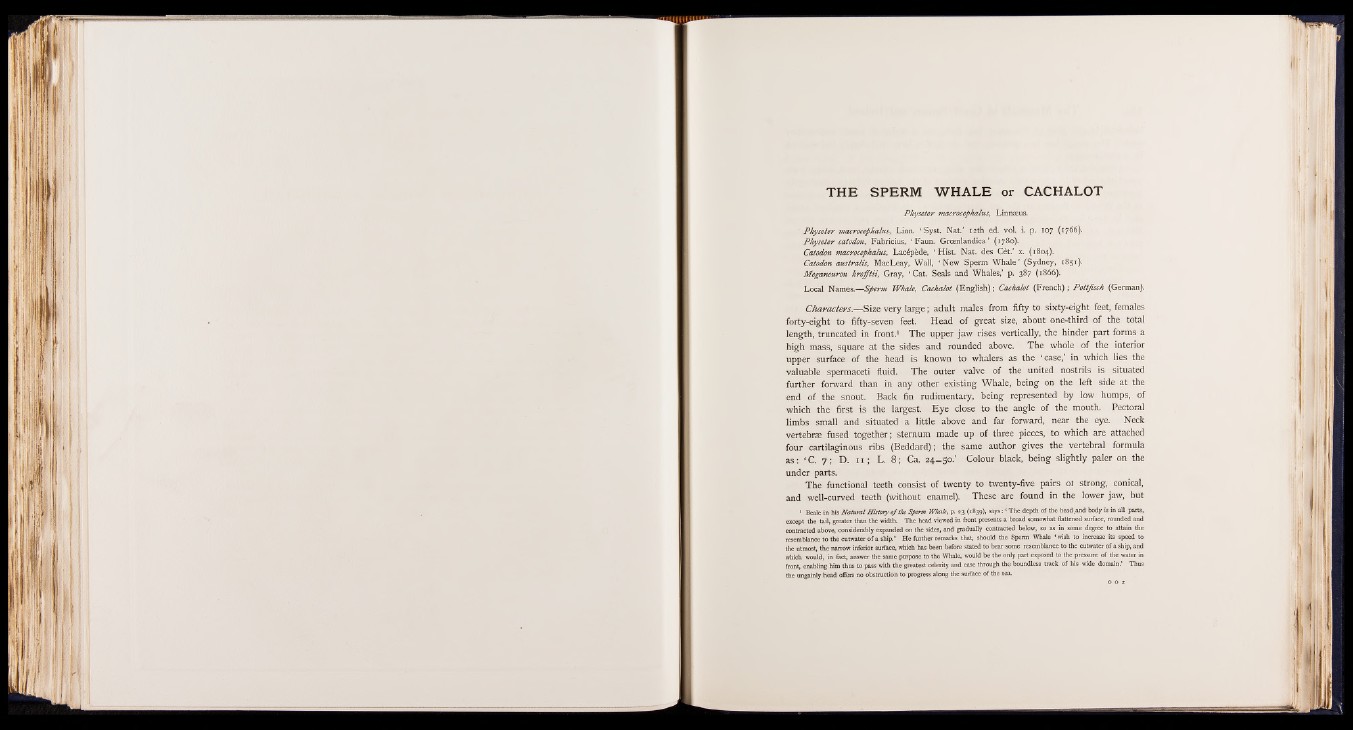
T H E S P E R M W H A L E or CACHALOT
Physeter macrocephalus, Linnaeus.
Physeter macrocephalus, Linn. ‘ Syst. Nat?’- 12th ed. vol. i. p. 107 (1766).
Physeter catodon, Fabricius, ‘ Faun. Groenlandica’ (1780).
Catodon macrocephalus, Lac^p&de, ‘ Hist. Nat. des C6t.’ x. (1804).
Catodon australis, MacLeay, Wall, ‘ New Sperm W h a le ’ (Sydney, 1851).
Meganeuron k re fftii, Gray, ‘ Cat. Seals and Whales,’ p. 387 (1866).
Local Names.— Sperm Whale, Cachalot (English); Cachalot (French) ; P ottfisch (German).
Characters.— Size very large; adult males from fifty to sixty-eight feet, females
forty-eight to fifty-seven feet. Head of great size, about one-third of the total
length, truncated in front.1 The upper jaw rises vertically, the hinder part forms a
high mass, square at the sides and rounded above. The whole of the interior
upper surface of the head is known to whalers as the ‘ case,’ in which lies the
valuable spermaceti fluid. The outer valve of the united nostrils is situated
further forward than in any other existing Whale, being on the left side at the
end of the snout. Back fin rudimentary, being represented by low humps, of
which the first is the largest. Eye close to the angle of the mouth. Pectoral
limbs small and situated a little above and far forward, near the eye. Neck
vertebrae fused together; sternum made up of three pieces, to which are attached
four cartilaginous ribs (Beddard); the same author gives the vertebral formula
a s : ‘ C. 7 ; D. 11 ; L. 8; Ca. 24=50.’ Colour black, being slightly paler on the
under parts.
The functional teeth consist of twenty to twenty-five pairs ot strong, conical,
and well-curved teeth (without enamel). These are found in the lower jaw, but
1 Beale in his Natural History o f the Sperm Whale, p. 23 (1839), says: ‘ The depth of the head.and body is in all parts,
except the tail, greater than the width. The head viewed in front presents a broad somewhat flattened surface, rounded and
contracted above, considerably expanded on the sides, and gradually contracted below, so as in some degree to attain the
resemblance to the cutwater of a ship.’ He further remarks that, should the Sperm Whale ‘ wish to increase its speed to
the utmost, the narrow inferior surface, which has been before stated to bear some resemblance to the cutwater of a ship, and
which would, in fact, answer the same purpose to the Whale, would be the only part exposed to the pressure of the water in
front, enabling him thus to pass with the greatest celerity and ease through the boundless track of his wide domain.’ Thus
the ungainly head offers no obstruction to progress along the surface of the sea.